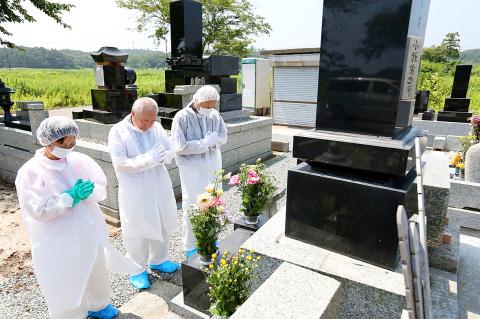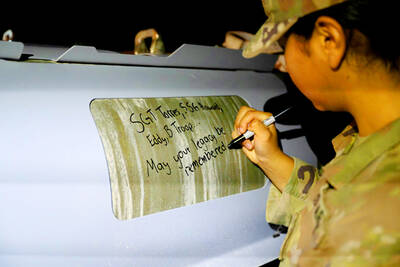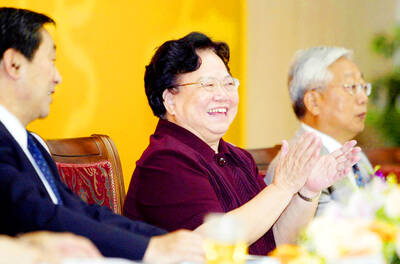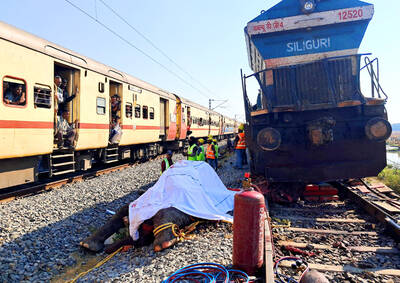The most ambitious radiation clean-up ever attempted has proved costly, complex and time-consuming since the Japanese government began it more than two years in the wake of the Fukushima Dai-ichi nuclear power plant meltdown. It may also fail.
Doubts are mounting that the effort to decontaminate hotspots in an area the size of Connecticut will succeed in its ultimate aim — luring more than 100,000 nuclear evacuees back home. If thousands of former residents cannot or will not return, parts of the farming and fishing region could remain an abandoned wilderness for decades.
In many areas, radiation remains well above targeted levels because of bureaucratic delays and ineffective work on the ground. As a result, some experts fear the US$15 billion allocated to the scheme so far will be largely squandered.

Photo: AFP
The deep-seated problems facing the clean-up are both economic and operational, according to a Reuters review of decontamination contracts and interviews with dozens of workers, managers and officials involved.
In Kawauchi, a heavily forested village in Fukushima Prefecture, decontamination crews have finished cleaning up houses, but few of their former inhabitants are prepared to move back. Just over 500 of the 3,000 people who once lived here have returned since the March 2011 meltdown at the Fukushima nuclear plant 25km to the east.
Even after being deemed safe enough for people to return, Kawauchi has no functioning hospital or high school.
The mushrooms that used to provide a livelihood for foragers are now steeped in dangerous levels of caesium. The only jobs on offer in town are menial. Some houses are so mildewed after three summers of abandonment that they need to be torn down.
The village has not only shrunk; its population has also aged. While the elderly used to make up a third of the town, they now account for 70 percent of residents.
The same pattern has played out across Fukushima as the nuclear accident turned the slow drip of urban flight by younger residents into a torrent, creating a demographic skew that decontamination is unlikely to reverse.
Kawauchi is one of the 11 townships that were most heavily contaminated after the accident, when rain and snow showered radioactive particles onto the verdant hills as the plume from the plant passed overhead. Half of it lies in the still-evacuated area where the national government has assumed control of the clean-up.
“There is no comprehensive plan on how to rebuild the village,” said Yasutsugu Igari, 34, who works in the reconstruction department at Kawauchi’s village office. “It’s the government that destroyed it, but now it’s doing very little to help us recreate our lives.”
Masayoshi Yokota, who is in charge of decontamination, says he has heard that frustration before.
“First they said they wouldn’t come back unless we decontaminated. So we did that and told them they could come back, but then it was about jobs or that they didn’t want to come back because they have children,” he said.
Japan’s plan to scrub clean the area around Fukushima and remove radioactive debris was beset by difficulties from the beginning.
Nothing on the same scale had ever been attempted before. After the Chernobyl accident in 1986, highly contaminated houses were entombed in concrete and the surrounding area was abandoned.
By contrast, Japan’s government is attempting to bring background radiation levels in the most highly contaminated evacuation zone to an average of 1 millisievert per year once all the work is completed.
That would be twice the background radiation level in Denver, or a sixth of the annual dose for the average American when all sources or radiation are taken into account. Japanese nuclear workers are limited to an accumulative exposure of 100 millisieverts over five years. Although radiation health experts assume that any incremental exposure to radiation increases risks for later cancers, the International Atomic Energy Agency say a statistically significant correlation only shows up at doses over that higher threshold.
The Japanese government decided to allow people to move back to areas with an average annual dose of less than 20 millisieverts in December 2011.
In an attempt to reach the tougher radiation target, thousands of temporary workers have been put to work scrubbing houses and roads, digging up topsoil and stripping trees of leaves into which invisible caesium particles have wormed.
Few of the hundreds of companies and small firms involved have any experience with radiation. Some workers have said they have been told to flush contaminated leaves away in rivers by supervisors to speed the job up and reduce waste, since storage remains a problem.
On a recent Saturday, a crew of 10 workers in jumpsuits, hardhats and surgical masks were clearing a roadside outside Kawauchi, picking up leaves and trimming weeds. The lower half of nearby forest slopes were stripped of saplings and shrubbery.
“That’s lovely,” Yokota told a visitor. “They’ve got it nice and clean.”
Some experts are doubtful about the payback of that effort.
“The truth of the matter is that from the European experience [after Chernobyl], remediation factors are disappointing,” said David Sanderson, a professor of environmental science at the University of Glasgow and an expert in radiation who has made numerous trips to Fukushima to map the fallout.

REVENGE: Trump said he had the support of the Syrian government for the strikes, which took place in response to an Islamic State attack on US soldiers last week The US launched large-scale airstrikes on more than 70 targets across Syria, the Pentagon said on Friday, fulfilling US President Donald Trump’s vow to strike back after the killing of two US soldiers. “This is not the beginning of a war — it is a declaration of vengeance,” US Secretary of Defense Pete Hegseth wrote on social media. “Today, we hunted and we killed our enemies. Lots of them. And we will continue.” The US Central Command said that fighter jets, attack helicopters and artillery targeted ISIS infrastructure and weapon sites. “All terrorists who are evil enough to attack Americans are hereby warned

The death of a former head of China’s one-child policy has been met not by tributes, but by castigation of the abandoned policy on social media this week. State media praised Peng Peiyun (彭珮雲), former head of China’s National Family Planning Commission from 1988 to 1998, as “an outstanding leader” in her work related to women and children. The reaction on Chinese social media to Peng’s death in Beijing on Sunday, just shy of her 96th birthday, was less positive. “Those children who were lost, naked, are waiting for you over there” in the afterlife, one person posted on China’s Sina Weibo platform. China’s

‘POLITICAL LOYALTY’: The move breaks with decades of precedent among US administrations, which have tended to leave career ambassadors in their posts US President Donald Trump’s administration has ordered dozens of US ambassadors to step down, people familiar with the matter said, a precedent-breaking recall that would leave embassies abroad without US Senate-confirmed leadership. The envoys, career diplomats who were almost all named to their jobs under former US president Joe Biden, were told over the phone in the past few days they needed to depart in the next few weeks, the people said. They would not be fired, but finding new roles would be a challenge given that many are far along in their careers and opportunities for senior diplomats can

Seven wild Asiatic elephants were killed and a calf was injured when a high-speed passenger train collided with a herd crossing the tracks in India’s northeastern state of Assam early yesterday, local authorities said. The train driver spotted the herd of about 100 elephants and used the emergency brakes, but the train still hit some of the animals, Indian Railways spokesman Kapinjal Kishore Sharma told reporters. Five train coaches and the engine derailed following the impact, but there were no human casualties, Sharma said. Veterinarians carried out autopsies on the dead elephants, which were to be buried later in the day. The accident site